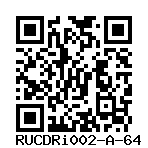LVIP05-RB1-CS2
RUCDRi002-A-64
General
Cell Line |
|
| hPSCreg name | RUCDRi002-A-64 |
| Cite as: | RUCDRi002-A-64 (RRID:CVCL_D6N1) |
| Alternative name(s) |
LVIP05-RB1-CS2
|
| Cell line type | Human induced pluripotent stem cell (hiPSC) |
| Similar lines |
RUCDRi002-A (TC-113, 50-001-21, 50-001-21.P20_10, ND50038, LiPSC-GR1.1, TC-1133) RUCDRi002-A-63 (LVIP05-RB1-CS1) RUCDRi002-A-65 (LVIP05-RB1-CS3) WAe001-A-10 (H1_RB1ex3_G3) WAe001-A-11 (H1_RB1ex3_G4) WAe001-A-31 (H1_RB1ex1_D6) WAe001-A-32 (H1_RB1ex1_E9) GENYOi006-A-1 (GRX-MCiPS4F-A2-ETO2-GLIS2) |
| Last update | 13th March 2024 |
| Notes | This is a human induced pluripotent stem cell line generated by CRISPR based editing of a healthy control iPSC line, RUCDRi002-A. It carries compound heterozygous in-del mutations in exon 18 of RB1, leading to frame shift in the reading frame of both the alleles and is predicted to result in premature translation termination and C-terminal truncated protein formation. The line has been stably maintained beyond passage 20, and expresses the stem cell markers OCT4, SOX2, NANOG, KLF4 and SSEA4, and has a normal karyotype. It can efficiently differentiate into all germ cell lineages. |
| User feedback | |
Provider |
|
| Generator |
L.V. Prasad Eye Institute (LVPEI)
Contact:
L.V. Prasad Eye Institute (LVPEI) |
| Owner | L.V. Prasad Eye Institute (LVPEI) |
| Distributors | |
| Derivation country | India |
External Databases |
|
| BioSamples | SAMEA114572969 |
| Cellosaurus | CVCL_D6N1 |
General Information |
|
| Publications |
|
| * Is the cell line readily obtainable for third parties? |
Yes Research use: allowed
Clinical use: not allowed
Commercial use: allowed
Additional restrictions:
Terms and conditions apply for commercial use |
| Subclone of | |
Donor Information
General Donor Information |
|
| Sex | male |
Phenotype and Disease related information (Donor) |
|
| Diseases | No disease was diagnosed.
|
Karyotyping (Donor) |
|
| Has the donor karyotype been analysed? |
Yes
Normal karyotype, 46, XY
Karyotyping method:
G-Banding
|
Other Genotyping (Donor) |
|
| Is there genome-wide genotyping or functional data available? |
No
|
External Databases (Donor) |
|
| BioSamples | SAMEA4938814 |
Ethics
Also have a look at the ethics information for the parental line
RUCDRi002-A
.
| Is there an MTA available for the cell line? | Yes |
| For generation of the cell line, who was the supplier of any recombined DNA vectors or commercial kits used? | The gene editing vector plasmid, lentiCRISPRv2, was obtained from Addgene. The RB1 targeting CRISPR guide oligo was then cloned into the BsmBI site, downstream of the U6 promoter. |
| Are you aware of any constraints on the use or distribution of the cell line from the owner or any parties identified in the query above? | Yes |
| Constraints for use or distribution | For research use only |
hIPSC Derivation
General |
|
|
The source cell information can be found in the parental cell line
RUCDRi002-A.
|
|
Reprogramming method |
|
| Vector type | Non-integrating |
| Vector | Episomal |
Vector free reprogramming |
|
| Type of used vector free reprogramming factor(s) |
None
|
Other |
|
| Derived under xeno-free conditions |
Yes |
| Derived under GMP? |
No |
| Available as clinical grade? |
No |
Culture Conditions
| Surface coating | Matrigel/Geltrex |
| Feeder cells |
No |
| Passage method |
Enzyme-free cell dissociation
EDTA
|
| CO2 Concentration | 5 % |
| Medium | Essential 8™ |
| Has Rock inhibitor (Y27632) been used at passage previously with this cell line? | Yes |
| Has Rock inhibitor (Y27632) been used at cryo previously with this cell line? | No |
| Has Rock inhibitor (Y27632) been used at thaw previously with this cell line? | Yes |
Characterisation
Analysis of Undifferentiated Cells
| Marker | Expressed | Immunostaining | RT-PCR | Flow Cytometry | Enzymatic Assay | Expression Profiles |
| POU5F1 (OCT-4) |
Yes |
|
|
|
||
| SOX2 |
Yes |
|
|
|||
| NANOG |
Yes |
|
|
|||
| KLF4 |
Yes |
|
||||
| SSEA-4 |
Yes |
|
|
|||
| cMYC |
Yes |
|
||||
| hTERT |
Yes |
|
Morphology pictures
Differentiation Potency
In vitro spontaneous differentiation
In vitro spontaneous differentiation
Morphology
Microbiology / Virus Screening |
|
| Mycoplasma | Negative |
Genotyping
Karyotyping (Cell Line) |
|
| Has the cell line karyotype been analysed? |
Yes
Normal karyotype, 46, XY
Passage number: 15
Karyotyping method:
G-Banding
|
Other Genotyping (Cell Line) |
|
Genetic Modification
| Disease/phenotype related modifications |
|


Login to share your feedback, experiences or results with the research community.